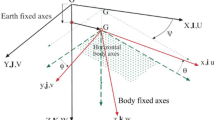Abstract
A comprehensive investigation of an asymmetric longitudinal motion of ships displayed in long and steep following waves is presented. The focus is on the strongly nonlinear response, on the verge of the so called surf-riding condition, where a ship could be performing large-amplitude longitudinal oscillations around a mean forward speed. Expressions, in closed form, describing transient surge motion on the phase-plane are derived. For steady-state in particular, is shown that it is possible to determine an explicit analytical solution in the time-domain. Simple prediction formulae for the higher limit of asymmetric surging (threshold of global surf-riding) are derived on the basis of two alternative methods. Also, we investigate the effect of asymmetric surging on a ship's tendency for capsize in the neighborhood of wave crests where restoring capability is often reduced. The paper includes, as an Appendix, a review of types of ship instability and a summary of the historical roots of the field.
Similar content being viewed by others
References
Grim, O., ‘Das Schiff in von achtern auflaufender See’, Jahrbuch der Schiffbautechnischen Gesellschaft 45, 1951, 264–287.
Makov, Y., ‘Some results of theoretical analysis of surf-riding in following seas (in Russian)’, Transactions of the Krylov Society 126, 1969, 124–128.
Grim, O., ‘Das Schiff in von achtern kommendem Seegang’, Schiffstechnik 30, 1983, 84–94.
Kan, M., ‘Surging of large amplitude and surf-riding of ships in following seas’, in Naval Architecture and Ocean Engineering, The Society of Naval Architects of Japan (eds.), 28, Ship and Ocean Foundation, Tokyo, 1990, 14 pp.
Umeda, N., ‘Probabilistic study of surf-riding of a ship in irregular following seas’, in Proceedings of the 4th International Conference on Stability of Ships and Ocean vehicles, Naples, Italy, 1990, pp. 336–343.
Spyrou, K. J., ‘Surf-riding and oscillations of a ship in quartering waves’, Journal of Marine Science and Technology 1(1), 1995, 24–36.
Spyrou, K. J., ‘Dynamic instability in quartering seas: The behavior of a ship during broaching’, Journal of Ship Research 40(1), 1996a, 46–59.
Spyrou, K. J., ‘Homoclinic connections and period doublings of a ship advancing in quartering waves’, CHAOS 6(2), 1996b, 209–218.
Grochowalski, S., Archibald, J. B., Conolly, F. J., and Lee, C. K., ‘Operational factors in stability safety of ships in heavy seas’, in Proceedings of the 5th International Conference on Stability of Ships and Ocean Vehicles STAB'94, Melbourne, FL, November 1994.
Umeda, N., Hamamoto, M., Takaishi, Y., Chiba, Y., Matsuda, A., Sera, W., Suzuki, S., Spyrou, K. J., Watanabe, K., Model experiments of ship capsize in astern seas’, Journal of the Society of Naval Architects of Japan, Tokyo, 177, 1995, 207–218.
De Kat, J. and Thomas, W. L., III, ‘Broaching and capsize model tests for validation of numerical ship motion predictions’, in Contemporary Ideas on Ship Stability, D. Vassalos et al. (eds.), Elsevier Science Ltd., Oxford, 2000, pp. 69–88, ISBN 0-08-043652-9.
IMO, Guidance to the Master for Avoiding Dangerous Situations in Following and Quartering Seas, MSC Circ. 707, London, 1995.
Thompson, J. M. T. and Stewart, H. B., Nonlinear Dynamics and Chaos, 2nd edn., Wiley, Chichester, UK, 2002, ISBN 0-471-87645-3.
Guckenheimer, J. and Holmes, P., Nonlinear Oscillations, Dynamical Systems and Bifurcations of Vector Fields, Springer-Verlag, New York, 1983.
Spyrou, K. J., ‘On the parametric rolling of ships in a following sea under simultaneous nonlinear periodic surging’, Philosophical Transactions, A 358(1771), 2000, The Royal Society of London, 1813–1834.
Hamamoto, M. and Panjaitan, J. P., ‘Analysis of parametric resonance of ships in astern seas’, in Proceedings of the Second Workshop on Stability and Operational Safety of Ships, Osaka University, Japan, November 18–19, 1996, pp. 36–46.
Bouguer, P., Traité du navire, de sa construction et de se mouvemens, Ant. Jombert (ed.), Paris, 1746.
Euler, L., Scientia navalis, Clifford Ambrose Truesdell (ed.) (in latin, republished by Birkhäuser, Switzerland), ISBN 3-7643-1448-6 (vol. 1), 3-7743-1449-4 (vol. 2), 1749.
Nowacki, H. and Fereiro, L., ‘Historical roots of the theory of hydrostatic stability of ships’, in Proceedings of the 8th International Conference on the Stability of Ships and Ocean Vehicles, L. P. Rojas (ed.), September 15–19, 2003, Madrid, pp 1–30.
Heath, T. L., The Works of Archimedes, Cambridge University Press (republished by Dover Publications in 2002, Cambridge, ISBN 0-486-42084-1), 1897.
Stein, S., Archimedes: What Did He Do Besides Cry Eureka? The Mathematical Accociation of America, ISBN 0-88385-718-9, 1999.
Nowacki, H., ‘Archimedes and ship stability’, in Proceedings of the International Conference on Passenger Ship Design, Operation and Safety, A. Papanikolaou and K. J. Spyrou (eds.), Crete, October 15–19, 2001, pp. 337–360.
Moseley, H., ‘On the dynamical stability and on the oscillation of floating bodies’, Philosophical Transactions of the Royal Society A 207, 1850, 609–643.
Froude, W., ‘On the rolling of ships’, Transactions of Institute of Naval Architects 2, 1861.
Froude, W., ‘Remarks on Mr. Scott Russel's paper on rolling’, Transactions of Institute of Naval Architects 3, 1863, 232–275.
Paulling, J. R. and Rosenberg, R. M., ‘On unstable ship motions resulting from nonlinear coupling’, Journal of Ship Research 41, 1959, 36–46.
Krylov, A. N., ‘A general theory of the oscillation of a ship in waves’, Transactions of Institute of Naval Architects 40, 1898.
ABS, Guide for the Parametric Roll for the Design of Container Carriers, Houston, TX, 2004, pp. 40.
Spyrou, K. J. and Thompson, J. M. T., ‘Theme issue: The nonlinear dynamics of ships’, Philosophical Transactions of the Royal Society A 358, 2000, 1735–1760.
Thompson, J. M. T., ‘Designing against capsize in beam seas: Recent advances and new insights’, Applied Mechanics Reviews 50(5), 1997, 307–325.
Author information
Authors and Affiliations
Corresponding author
Additional information
For a better introduction to the subject we include, as Appendix A, a historical note on the evolution of the theory ship stability together with a summary of known types of ship instability distinguished on the basis of the angle of encounter between ship and waves.
Rights and permissions
About this article
Cite this article
Spyrou, K.J. Asymmetric Surging of Ships in Following Seas and its Repercussions for Safety. Nonlinear Dyn 43, 149–172 (2006). https://doi.org/10.1007/s11071-006-0758-6
Received:
Accepted:
Issue Date:
DOI: https://doi.org/10.1007/s11071-006-0758-6




